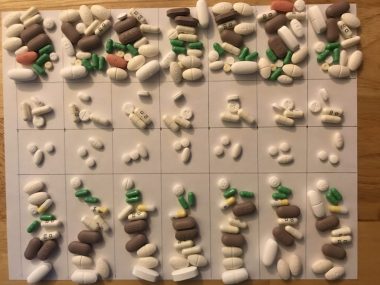Medication Management in a Post-transplant World

Every day in my post-transplant world begins with morning doses and ends with evening doses of medication. I also take doses in between, totaling 33–34 pills a day. Medication management is central in the life of a transplant recipient.
I received a bilateral lung transplant on this past July 10. I was discharged from the hospital 10 days later, carrying a satchel of medications and a template of instructions. The template became my medication list. It is a living document that I update weekly, sometimes biweekly. I add a footnote to the list every time a medication is added, removed, or changed. Since my discharge on July 20, I have added 57 footnotes.
Wednesday night is date night
Every Wednesday evening, my wife, Susan, and I sit down with my medication list, a plastic tub of medications, and a pill container for the week. We both have a view of the list. Susan pulls the medication from the tub and counts out the pills. She hands them off to me, and after verifying the pill, I put each dose into the proper bin of the weekly pill container.
We have learned to recognize most of the pills on sight and have developed a method for ordering timely refills. Every change to the medication list generates a new footnote, indicating the medication, the dosage, the type of change, the date, and the member of my care team making the change.

My medications for one week in a post-transplant world. (Photo by Sam Kirton)
The important part
These medications must be correct and administered on time. That’s why, when possible, Susan and I work together to organize my weekly medications, noting any changes that must be made. I am currently having labs drawn every one to two weeks. Often, those labs result in a change to my medications.
Today, I am completely off the medications that don’t fit in my pill container. Daily injections of Lovenox (enoxaparin sodium) and Mepron (atovaquone), a liquid I affectionately called “yellow paint,” are no longer in my medication rotation.
You do you
This method works for me, but find the medication management method that works best for you. It may not be perfect from the beginning, so don’t be afraid to make adjustments.
Managing your medications is just one more way to ensure you’re making every breath count.
How do you manage your medications? Share your methods in the comments below.
Note: Pulmonary Fibrosis News is strictly a news and information website about the disease. It does not provide medical advice, diagnosis, or treatment. This content is not intended to be a substitute for professional medical advice, diagnosis, or treatment. Always seek the advice of your physician or other qualified health provider with any questions you may have regarding a medical condition. Never disregard professional medical advice or delay in seeking it because of something you have read on this website. The opinions expressed in this column are not those of Pulmonary Fibrosis News or its parent company, Bionews, and are intended to spark discussion about issues pertaining to pulmonary fibrosis.









John Gould
That mountain of pills you're showing will be my future after my future transplant - with so many pills to take, was there any room left for food?
Did any of your pills or combination of pills trigger the runs?
If so how did the Drs figure out which did and how did they get the runs under control?
If I'm not very careful with my Ofev and Metformin and stress now pre transplant I get the runs and stopping them takes work.
Thanks
John